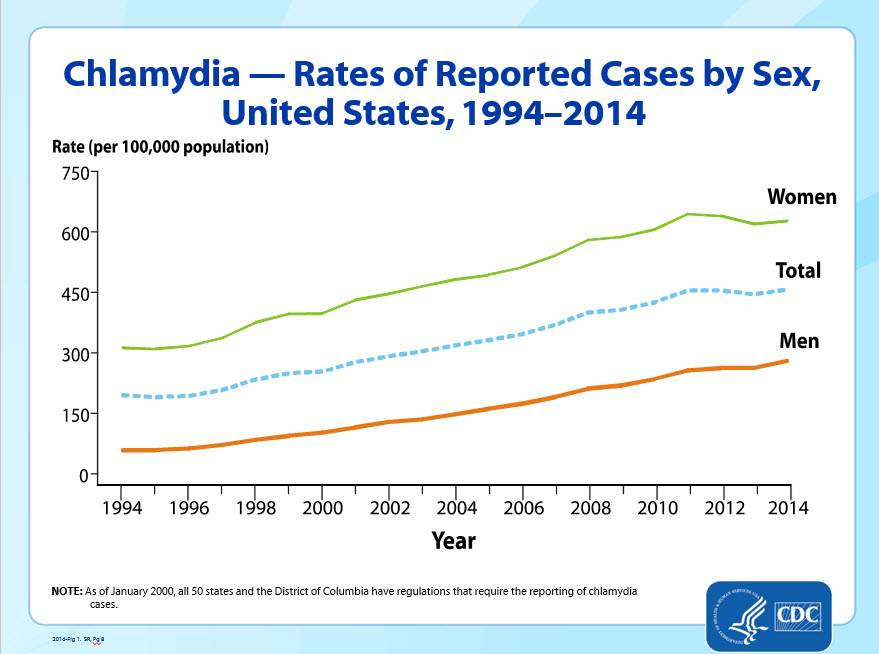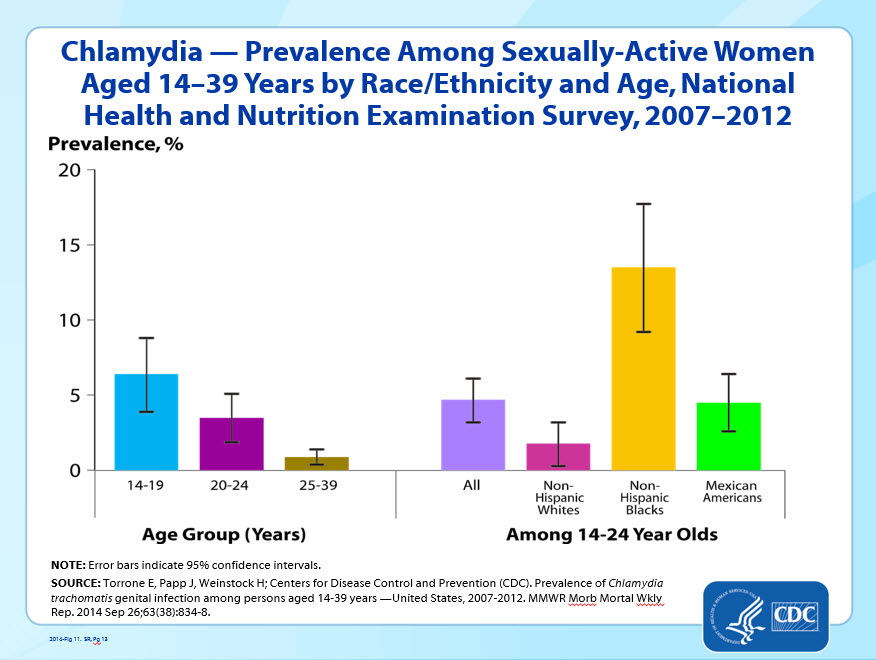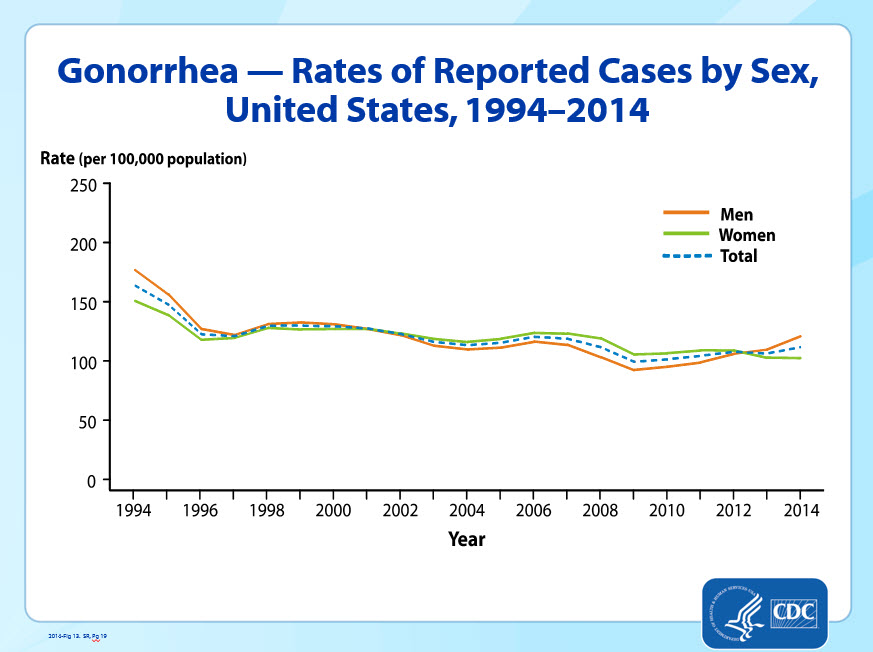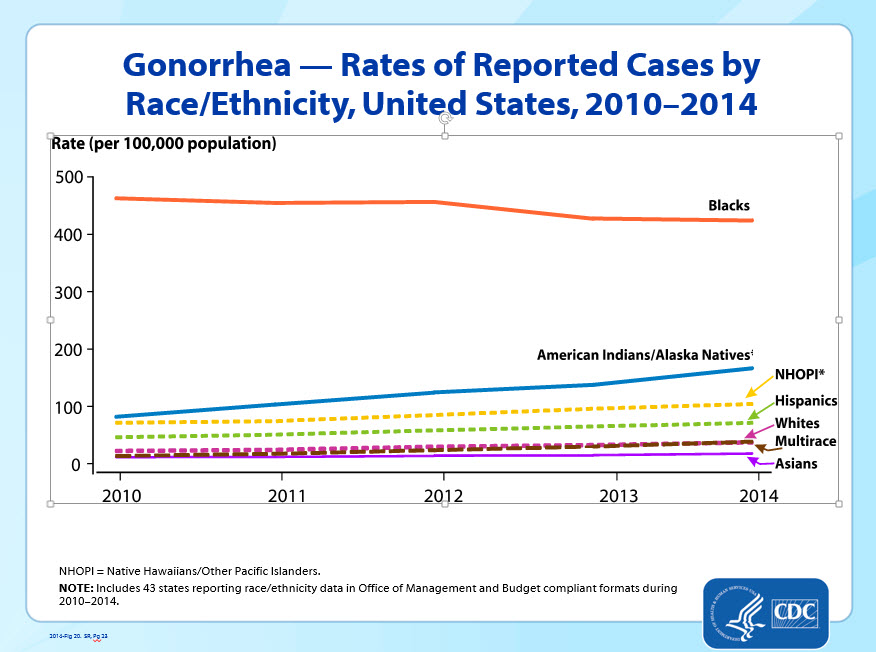Urethritis epidemiology and demographics: Difference between revisions
(Category) |
Zehra Malik (talk | contribs) |
||
| (11 intermediate revisions by 2 users not shown) | |||
| Line 3: | Line 3: | ||
{{CMG}}; {{AE}} {{MehdiP}} | {{CMG}}; {{AE}} {{MehdiP}} | ||
==Overview== | ==Overview== | ||
Urethritis is the cause of several millions of healthcare visits in the United States. | Urethritis is the cause of several millions of healthcare visits in the United States. ''[[Chlamydia trachomatis]]'' is the most common reportable [[disease]] in the US. In 2014, a total of 350,062 [[gonorrhea]] cases were reported to the CDC in the US. Based on The National Health and Nutrition Examination Survey, the overall [[prevalence]] of [[chlamydia]] among persons aged 14–39 years was 1.7% during 2007-2012. Urethritis has a very good [[prognosis]] with proper [[treatment]]. [[Mortality]] is very uncommon in [[patients]] with [[Gonorrhea|gonococcal]] and [[non-gonococcal urethritis]]. Almost two-thirds of [[chlamydia]] [[infections]] occur among youths aged 15-24 years. The highest [[prevalence]] rates of [[Gonorrhea|gonococcal]] urethritis were found in ages 20 to 24 years both in men and women. In 2014, the overall rate of [[chlamydia]] [[infection]] in the United States among women was 627.2 cases per 100,000 females, over two times the rate among men (278.4 cases per 100,000 males). In 2014, the [[incidence]] of [[gonorrhea]] in the United States was reported as 120 cases per 100,000 males, while it was reported as 100 cases per 100,000 [[females]]. | ||
==Epidemiology | ==Epidemiology and Demographics== | ||
===Incidence=== | ===Incidence=== | ||
*'' | *''[[Chlamydia trachomatis]]'' is the most common reportable disease in the US. In 2014, a total of 1,441,789 [[Chlamydia infection|chlamydial]] infections were reported to the CDC. | ||
* | * In 2014, the incidence of urethritis due to ''[[Chlamydia trachomatis]]'' infection was estimated to be 456 cases per 100,000 individuals in the US. | ||
*In 2014, a total of 350,062 [[gonorrhea]] cases were reported to the CDC in the US.<ref name="urlNational Overview - 2014 STD Surveillance">{{cite web |url=http://www.cdc.gov/std/stats14/natoverview.htm |title=National Overview - 2014 STD Surveillance |format= |work= |accessdate=}}</ref> | |||
*In 2014, the incidence of urethritis due to [[N. gonorrheae|''N. gonorrhea'']] infection was estimated to be 110.7 cases per 100,000 individuals in the US. | |||
*Worldwide, there are an estimated 78 million [[gonorrhea]] cases, and 131 million cases of [[Chlamydia infection|chlamydia]] yearly.<ref name="who">WHO epidemiology http://www.who.int/mediacentre/factsheets/fs110/en/ (2016) Accessed on September 26, 2016</ref><ref name="pmid25254560">{{cite journal |vauthors=Torrone E, Papp J, Weinstock H |title=Prevalence of Chlamydia trachomatis genital infection among persons aged 14-39 years--United States, 2007-2012 |journal=MMWR Morb. Mortal. Wkly. Rep. |volume=63 |issue=38 |pages=834–8 |year=2014 |pmid=25254560 |doi= |url=}}</ref> | |||
===Prevalence=== | ===Prevalence=== | ||
Based on The National Health and Nutrition Examination Survey, the overall prevalence of [[chlamydia]] among persons aged 14–39 years was 1.7% | * Based on The National Health and Nutrition Examination Survey, the overall prevalence of [[chlamydia]] among persons aged 14–39 years was 1.7% during 2007-2012.<ref name="urlChlamydia - 2014 STD Surveillance">{{cite web |url=http://www.cdc.gov/std/stats14/chlamydia.htm |title=Chlamydia - 2014 STD Surveillance |format= |work= |accessdate=}}</ref> | ||
= | ===Mortality rate=== | ||
* Urethritis has a very good prognosis with proper treatment. Mortality is very uncommon in patients with [[Gonorrhea|gonococcal]] and non-gonococcal urethritis. | |||
== | |||
* | |||
===Age=== | ===Age=== | ||
* | *''[[Chlamydia trachomatis]]'' | ||
* | **Almost two-thirds of [[chlamydia]] infections occur among youths aged 15-24 years.<ref name="abc">Chlamydia CDC Fact Sheet. CDC.http://www.cdc.gov/std/chlamydia/stdfact-chlamydia-detailed.htm#_ENREF_3. Accessed on September 28,2016</ref> | ||
*''[[Gonorrhea]]'' | |||
**The highest prevalence rates were found in ages 20 to 24 years both in men and women. | |||
===Race=== | ===Race=== | ||
*'' | *[[Chlamydia trachomatis|''Chlamydia trachomatis'']]<ref name="urlChlamydia - 2014 STD Surveillance">{{cite web |url=http://www.cdc.gov/std/stats14/chlamydia.htm |title=Chlamydia - 2014 STD Surveillance |format= |work= |accessdate=}}</ref> | ||
* | **In 2014, the [[chlamydia]] rate in African-Americans was 6 times the rate in Caucasians. | ||
**The rate among American Indians/Alaska Natives was almost 4 times the rate among Caucasians. | |||
*[[Gonorrhea|''Gonorrhea'']]<ref name="urlChlamydia - 2014 STD Surveillance">{{cite web |url=http://www.cdc.gov/std/stats14/chlamydia.htm |title=Chlamydia - 2014 STD Surveillance |format= |work= |accessdate=}}</ref> | |||
**In 2014, the rate of reported [[gonorrhea]] cases remained highest among African-Americans (405.4 cases per 100,000 individuals). | |||
**The rate among African-Americans was 10.6 times the rate among Caucasians (38.3 cases per 100,000 population). | |||
**The [[gonorrhea]] rate among American Indians/Alaska natives was 159.4 cases per 100,000 individuals, 4.2 times that of Caucasians. | |||
<gallery> | <gallery> | ||
| Line 37: | Line 41: | ||
</gallery> | </gallery> | ||
Graphs adapted from https://www.cdc.gov/ | Graphs adapted from https://www.cdc.gov/ | ||
===Gender=== | |||
*''[[Chlamydia trachomatis]]'' | |||
**In 2014, the overall rate of [[chlamydia]] infection in the United States among women was 627.2 cases per 100,000 females, over two times the rate among men (278.4 cases per 100,000 males).<ref name="urlNational Overview - 2014 STD Surveillance">{{cite web |url=http://www.cdc.gov/std/stats14/natoverview.htm |title=National Overview - 2014 STD Surveillance |format= |work= |accessdate=}}</ref> | |||
*''[[Gonorrhea]]'' | |||
**In 2014, incidence of [[gonorrhea]] in the United States was reported as 120 cases per 100,000 males, while it was reported as 100 cases per 100,000 female. | |||
==References== | ==References== | ||
{{Reflist|2}} | {{Reflist|2}} | ||
[[Category:Medicine]] | |||
[[Category: | [[Category:Emergency medicine]] | ||
[[Category:Up-To-Date]] | [[Category:Up-To-Date]] | ||
[[Category:Infectious disease]] | [[Category:Infectious disease]] | ||
[[Category:Urology]] | [[Category:Urology]] | ||
[[Category:Nephrology]] | [[Category:Nephrology]] | ||
Latest revision as of 16:00, 27 August 2021
|
Urethritis Microchapters | |
|
Diagnosis | |
|
Treatment | |
|
Case Studies | |
|
Urethritis epidemiology and demographics On the Web | |
|
American Roentgen Ray Society Images of Urethritis epidemiology and demographics | |
|
Risk calculators and risk factors for Urethritis epidemiology and demographics | |
Editor-In-Chief: C. Michael Gibson, M.S., M.D. [1]; Associate Editor(s)-in-Chief: Seyedmahdi Pahlavani, M.D. [2]
Overview
Urethritis is the cause of several millions of healthcare visits in the United States. Chlamydia trachomatis is the most common reportable disease in the US. In 2014, a total of 350,062 gonorrhea cases were reported to the CDC in the US. Based on The National Health and Nutrition Examination Survey, the overall prevalence of chlamydia among persons aged 14–39 years was 1.7% during 2007-2012. Urethritis has a very good prognosis with proper treatment. Mortality is very uncommon in patients with gonococcal and non-gonococcal urethritis. Almost two-thirds of chlamydia infections occur among youths aged 15-24 years. The highest prevalence rates of gonococcal urethritis were found in ages 20 to 24 years both in men and women. In 2014, the overall rate of chlamydia infection in the United States among women was 627.2 cases per 100,000 females, over two times the rate among men (278.4 cases per 100,000 males). In 2014, the incidence of gonorrhea in the United States was reported as 120 cases per 100,000 males, while it was reported as 100 cases per 100,000 females.
Epidemiology and Demographics
Incidence
- Chlamydia trachomatis is the most common reportable disease in the US. In 2014, a total of 1,441,789 chlamydial infections were reported to the CDC.
- In 2014, the incidence of urethritis due to Chlamydia trachomatis infection was estimated to be 456 cases per 100,000 individuals in the US.
- In 2014, a total of 350,062 gonorrhea cases were reported to the CDC in the US.[1]
- In 2014, the incidence of urethritis due to N. gonorrhea infection was estimated to be 110.7 cases per 100,000 individuals in the US.
- Worldwide, there are an estimated 78 million gonorrhea cases, and 131 million cases of chlamydia yearly.[2][3]
Prevalence
- Based on The National Health and Nutrition Examination Survey, the overall prevalence of chlamydia among persons aged 14–39 years was 1.7% during 2007-2012.[4]
Mortality rate
- Urethritis has a very good prognosis with proper treatment. Mortality is very uncommon in patients with gonococcal and non-gonococcal urethritis.
Age
- Chlamydia trachomatis
- Gonorrhea
- The highest prevalence rates were found in ages 20 to 24 years both in men and women.
Race
- Chlamydia trachomatis[4]
- In 2014, the chlamydia rate in African-Americans was 6 times the rate in Caucasians.
- The rate among American Indians/Alaska Natives was almost 4 times the rate among Caucasians.
- Gonorrhea[4]
- In 2014, the rate of reported gonorrhea cases remained highest among African-Americans (405.4 cases per 100,000 individuals).
- The rate among African-Americans was 10.6 times the rate among Caucasians (38.3 cases per 100,000 population).
- The gonorrhea rate among American Indians/Alaska natives was 159.4 cases per 100,000 individuals, 4.2 times that of Caucasians.
-
Rate of Chlamydia reported cases by gender
-
Chlamydia Prevalence by race and age
-
Rate of Gonorrhea reported cases by sex
-
Gonorrhea Prevalence by race
Graphs adapted from https://www.cdc.gov/
Gender
- Chlamydia trachomatis
- Gonorrhea
- In 2014, incidence of gonorrhea in the United States was reported as 120 cases per 100,000 males, while it was reported as 100 cases per 100,000 female.
References
- ↑ 1.0 1.1 "National Overview - 2014 STD Surveillance".
- ↑ WHO epidemiology http://www.who.int/mediacentre/factsheets/fs110/en/ (2016) Accessed on September 26, 2016
- ↑ Torrone E, Papp J, Weinstock H (2014). "Prevalence of Chlamydia trachomatis genital infection among persons aged 14-39 years--United States, 2007-2012". MMWR Morb. Mortal. Wkly. Rep. 63 (38): 834–8. PMID 25254560.
- ↑ 4.0 4.1 4.2 "Chlamydia - 2014 STD Surveillance".
- ↑ Chlamydia CDC Fact Sheet. CDC.http://www.cdc.gov/std/chlamydia/stdfact-chlamydia-detailed.htm#_ENREF_3. Accessed on September 28,2016



